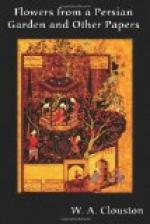The Emperor’s Dream.
An emperor of China dreamt of a very beautiful damsel whom he had never seen or heard of, and, being sorely pierced with the darts of love for the creature of his dreaming fancy, he could find no peace of mind. One of his vazirs, who was an excellent portrait painter, receiving from the emperor a minute description of the lady’s features, drew the face, and the imperial lover acknowledged the likeness to be very exact. The vazir then went abroad with the portrait, to see whether any one could identify it with the fair original. After many disappointments he met with an old hermit, who at once recognised it as the portrait of the princess of Rum,[46] who, he informed the vazir, had an unconquerable aversion against men ever since she beheld, in her garden, a peacock basely desert his mate and their young ones, when the tree on which their nest was built had been struck by lightning. She believed that all men were quite as selfish as that peacock, and was resolved never to marry. Returning to his imperial master with these most interesting particulars regarding the object of his affection, he next undertakes to conquer the strange and unnatural aversion of the princess. Taking with him the emperor’s portrait and other pictures, he procures access to the princess of Rum; shows her, first, the portrait of the emperor of China, and then pictures of animals in the royal menagerie, among others that of a deer, concerning which he relates a story to the effect that the emperor, sitting one day in his summer-house, saw a deer, his doe, and their fawn on the bank of the river, when suddenly the waters overflowed the banks, and the doe, in terror for her life, fled away, while the deer bravely remained with the fawn and was drowned. This story, so closely resembling her own, struck the fair princess with wonder and admiration, and she at once gave her consent to be united to the emperor of China; and we may suppose that “they continued together in joy and happiness until they were overtaken by the terminater of delights and the separator of companions.”
[46] Originally, Rumelia (Rum Eyli)
was only implied by the
word
Rum, but in course of time it was employed to
designate
the whole Turkish empire.
* * * * *
There can be little or no doubt, I think, that in this tale we find the original of the frame, or leading story, of the Persian Tales, ascribed to a dervish named Mukhlis, of Isfahan, and written after the Arabian Nights, as it is believed, in which the nurse of the Princess has to relate almost as many stories to overcome her aversion against men (the result of an incident similar to that witnessed by the Lady of Rum) as the renowned Sheherazade had to tell her lord, who entertained—for a very different reason—a bitter dislike of women.




